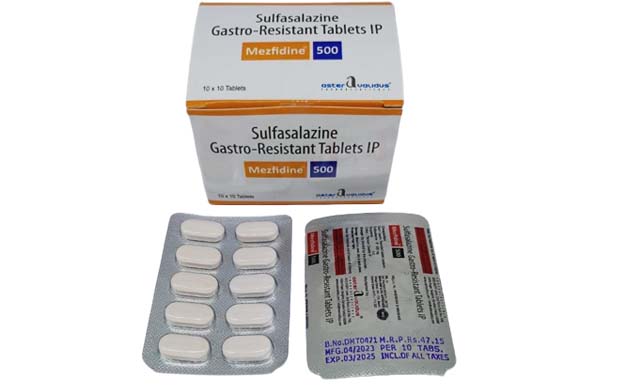Therapeutic Indication
● Crohn's Disease (CD)
● Polyarticular juvenile rheumatoid arthritis, chronic or unspecified
● Proctitis
● Rheumatoid Arthritis
● Severe Ulcerative Colitis
● Mild Ulcerative Colitis
● Moderate Ulcerative colitis
Pharmacology
Mechanism of Action:
Sulfasalazine (SSZ) is a prodrug composed of 5-aminosalicylic acid (5-ASA) linked to sulfapyridine through an azo bond and shows anti-inflammatory action. The mode of action of Sulfasalazine or its metabolites, 5-aminosalicylic acid (5-ASA) and sulfapyridine (SP), is still under investigation, but may be related to the anti-inflammatory and/or immunomodulatory properties, to its affinity for connective tissue, and/or to the relatively high concentration it reaches in serous fluids, the liver and intestinal walls, as demonstrated in autoradiographic studies in animals. In ulcerative colitis, clinical studies utilizing rectal administration of Sulfasalazine, SP and 5-ASA have indicated that the major therapeutic action may reside in the 5-ASA moiety. The relative contribution of the parent drug and the major metabolites in rheumatoid arthritis is unknown.
Pharmacokinetics:
Approximately 30 percent of orally administered SSZ, which therapeutically is a relatively inactive chemical, is rapidly absorbed by the small bowel and is then returned, largely unaltered, via the enterohepatic circulation into the bile. Thus, approximately 90 percent of the ingested drug reaches the large intestine as an intact molecule. In the colon, SSZ is reduced by the bacterial enzyme azoreductase to its two components, sulfapyridine and 5-ASA. Thus, coliform bacteria are necessary to reduce the relatively inactive parent drug to its active moieties. Nearly all of the sulfapyridine is absorbed, while 5-ASA is largely excreted in the feces, consistent with the utility of 5-ASA in inflammatory bowel disease (IBD). Half-life of drug is approximately 5-10 hours.
Side Effects
Common side effects of drug include:
● Loss of appetite
● Nausea
● Headache
● Rash.
Immediately discontinue the use if severe side effects are observed and consult your physician.
Contraindication
The drug should not be used in the following conditions:
● A bad infection
● Glucose-6-phosphate dehydrogenase (G6PD) deficiency
● Porphyria
● Low blood counts due to bone marrow failure
● Low levels of a type of white blood cell called neutrophils
● Asthma
● Blockage of the stomach or intestine
● Liver problems
● Decreased kidney function
Interaction
Some products that may interact with this drug include:
● Digoxin
● Folic acid
● Methenamine
● PABA taken by mouth.
● Sulfasalazine is very similar to mesalamine. Do not use mesalamine medications taken by mouth while using sulfasalazine.
